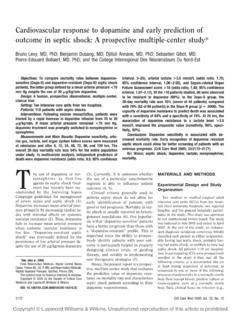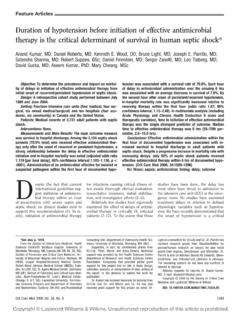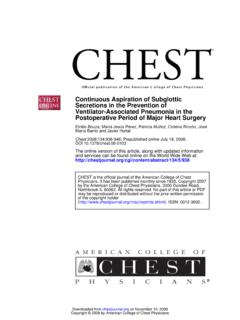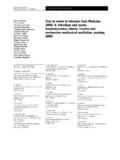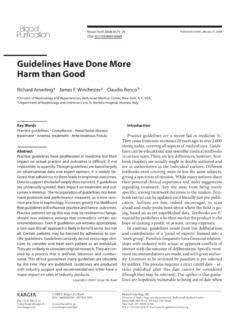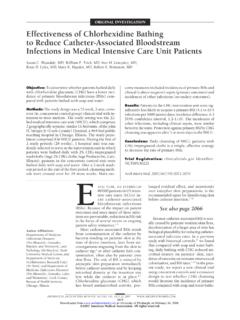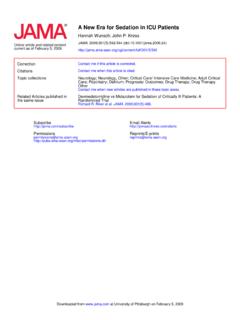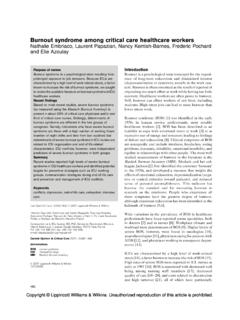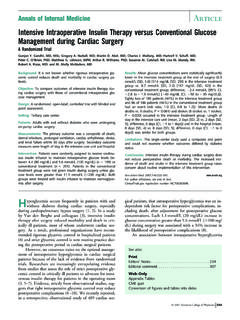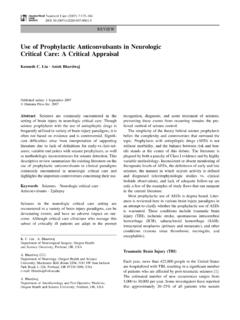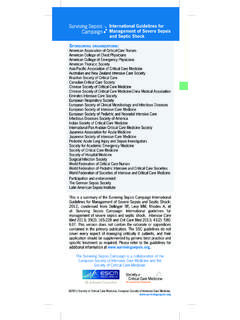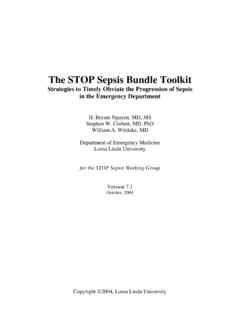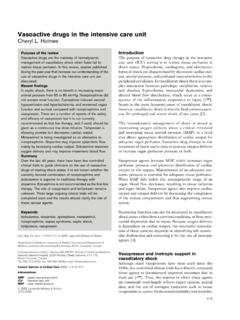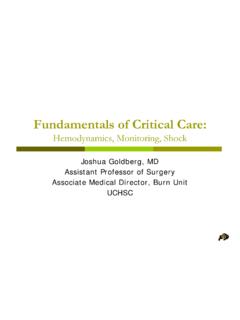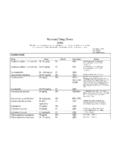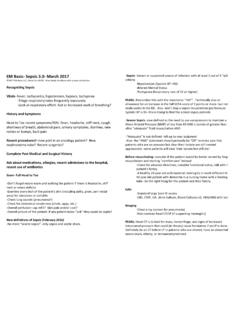Transcription of Feature Articles - ccmpitt.com
1 Feature ArticlesDoes dopamine administration in shock influence outcome?Results of the Sepsis Occurrence in Acutely Ill Patients (SOAP)Study*Yasser Sakr, MB, BCh, MSc; Konrad Reinhart, MD, PhD; Jean-Louis Vincent, MD, PhD, FCCP;Charles L. Sprung, MD; Rui Moreno, MD, PhD; V. Marco Ranieri, MD; Daniel De Backer, MD, PhD;Didier Payen, MDThe optimal adrenergic supportin shock is controversial. Do-pamine and norepinephrineare the most commonly usedagents to restore tissue perfusion pres-sure in these conditions. Although dopa-mine is the natural precursor of norepi-nephrine, and both combine - and -adrenergic properties, they are differ-ent molecules and have different pharma-cologic profiles.
2 Dopamine has relativelystronger 1-adrenergic properties, thusincreasing myocardial contractility morethan norepinephrine, which has rela-tively stronger -adrenergic propertiesand thus increases arterial pressure andsystemic vascular resistance more have their advantages and poten-tial disadvantages, although many of thesuggested effects of vasopressors have notbeen demonstrated in humans, particu-larly in those with critical illness. Dopa-mine is more likely to increase cardiacoutput and may also preferentially dis-tribute blood flow to the splanchnic andrenal vasculature by its additional dopa-minergic properties (1, 2). Dopaminemay have beneficial effects on diaphrag-matic function (3) and on the resorptionof edema fluid (4, 5).
3 However, it mayincrease heart rate and can producetachyarrhythmias. Dopamine may alsosuppress pituitary function, particularlyprolactin secretion (6).Norepinephrine is a more potent vaso-constrictor, through its potent 1stimu-lation with moderate 1and minimal 2activity. Norepinephrine was found to bemore effective than dopamine in restor-ing hemodynamic stability and evensometimes urine output in patients withsepsis (7). Concerns with the use of nor-epinephrine are the potential risks of ex-cessive vasoconstriction and decreasedObjective:The optimal adrenergic support in shock is contro-versial. We investigated whether dopamine administration influ-ences the outcome from :Cohort, multiple-center, observational :One hundred and ninety-eight European intensive :All adult patients admitted to a participating inten-sive care unit between May 1 and May 15, and Main Results:Patients were followed upuntil death, until hospital discharge, or for 60 days.
4 Shock wasdefined as hemodynamic compromise necessitating the adminis-tration of vasopressor catecholamines. Of 3,147 patients, 1,058( ) had shock at any time; 462 ( ) had septic shock. Theintensive care unit mortality rate for shock was and septic shock. Of patients in shock, 375 ( ) receiveddopamine (dopamine group) and 683 ( ) never receiveddopamine. Age, gender, Simplified Acute Physiology Score II, andSequential Organ Failure Assessment score were comparablebetween the two groups. The dopamine group had higher inten-sive care unit ( vs. ,p .02) and hospital ( ,p .01) mortality rates. A Kaplan-Meier survival curveshowed diminished 30 day-survival in the dopamine group (logrank ,p.)
5 032). In a multivariate analysis with intensivecare unit outcome as the dependent factor, age, cancer, medicaladmissions, higher mean Sequential Organ Failure Assessmentscore, higher mean fluid balance, and dopamine administrationwere independent risk factors for intensive care unit mortality inpatients with :This observational study suggests that dopamineadministration may be associated with increased mortality ratesin shock. There is a need for a prospective study comparingdopamine with other catecholamines in the management of cir-culatory shock. (Crit Care Med 2006; 34:589 597)KEYWORDS: vasopressors; catecholamines; vasoactive agents;acute circulatory failure; survival; intensive care*See also p.
6 The Department of Intensive Care, Erasme Hos-pital, Free University of Brussels, Belgium (YS, J-LV,DDB); Department of Anesthesiology and Intensive Care,Friedrich-Schiller-University, Jena, Germany (KR); Depart-ment of Anesthesiology and Critical Care Medicine, Ha-dassah Hebrew University Medical Center, Jerusalem,Israel (CLS); Department for Intensive Care, Hospital deSt, Antonio dos Capuchos, Lisbon, Portugal (RM); Depart-ment of Anesthesiology and Intensive Care, S. GiovanniBattista Hospital, University of Turin, Italy (VMR); andDepartment of Anesthesiology and Intensive Care, CentreHospitalier Universitaire Lariboisiere, Paris, France (DP).Endorsed by the European Society of IntensiveCare Medicine and supported by an unrestricted grantfrom Abbott, Baxter, Eli Lilly, GlaxoSmithKline, authors have no financial involvement thatmight pose a conflict interest in connection with 2006 by the Society of Critical CareMedicine and Lippincott Williams & WilkinsDOI: Care Med 2006 Vol.
7 34, No. 3organ perfusion. However, the combina-tion of norepinephrine with dobutaminemay counteract this effect (8).In a large cohort of European inten-sive care unit (ICU) patients included inthe Sepsis Occurrence in Critically Ill Pa-tients (SOAP) study, we determinedwhether dopamine administration wasassociated with a poor outcome in pa-tients with shock due to any cause and ina subgroup of septic shock patients, andwe identified other factors associatedwith a poor outcome in these the study was purely observa-tional, multivariate analyses can help toidentify important report is the result of asubstudy from the SOAP database: a prospec-tive, multiple-center, observational study thatwas designed to evaluate the epidemiology ofsepsis in European countries and was initiatedby a working group of the European Society ofIntensive Care Medicine.
8 Institutional recruit-ment for participation was by open invitationfrom the study steering committee to Euro-pean ICUs. Since this epidemiologic, observa-tional study did not require any deviation fromroutine medical practice, institutional reviewboard approval was either waived or expeditedin participating institutions and informedconsent was not required. We included alladult patients ( 15 yrs) admitted to the par-ticipating centers (see the Appendix for a listof participating countries and centers) be-tween May 1 and May 15, 2002. Patients werefollowed up until death or hospital dischargeor for 60 days. Those who stayed in the ICU for 24 hrs for routine postoperative observation,and patients with burns, were were collectedprospectively using preprinted case reportforms.
9 Detailed instructions, explaining theaim of the study, instructions for data collec-tion, and definitions for various importantitems were available for all participantsthrough an Internet-based Web site beforestarting data collection and throughout thestudy period. The steering committee main-tained continuous contact with the investiga-tors and processed all queries during data were entered centrally by medicalpersonnel using the SPSS version forWindows (SPSS, Chicago, IL). A random sam-ple of 5% of data was reentered by a differentencoder and revised by a third; a consistencyof per variable and per patientwas observed during the whole process of dataentry. In case of inconsistency, data were ver-ified and corrected.
10 Daily frequency tableswere reviewed for all variables, and the inves-tigators were queried when data values eitherwere questionable or were missing for re-quired fields. There was no data quality con-trol at the data collection level. Data collectionon admission included demographic data andcomorbid diseases. Clinical and laboratorydata for Simplified Acute Physiology Score(SAPS) II (9) were reported as the worst valuewithin 24 hrs after admission. Microbiologicaland clinical infections were reported daily asTable use in patients with shock (%)Any Shock(n 1058)Septic Shock(n 462)Nonseptic Shock(n 596)pValueAlone or in combinationNorepinephrine848 ( )386 ( )462 ( ).015 Dopamine375 ( )181 ( )194 ( ).
